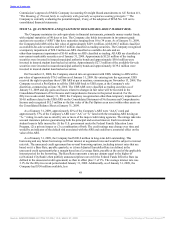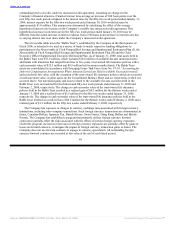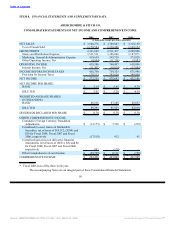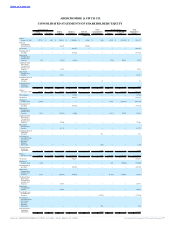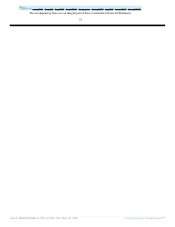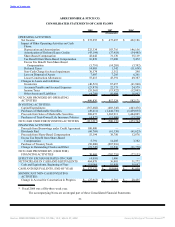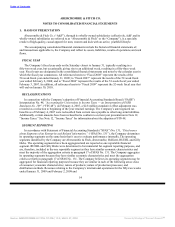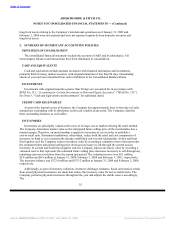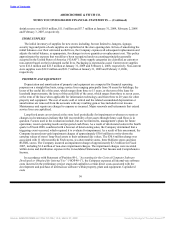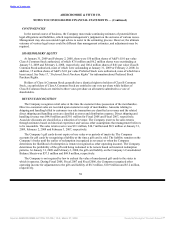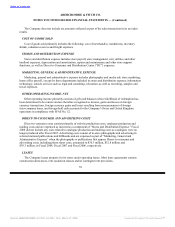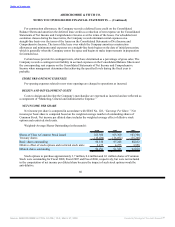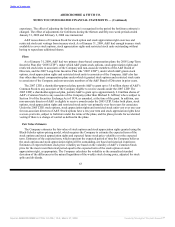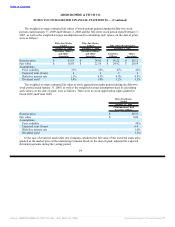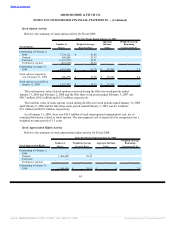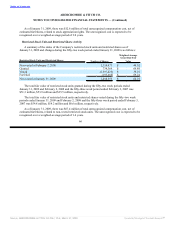Abercrombie & Fitch 2008 Annual Report Download - page 60
Download and view the complete annual report
Please find page 60 of the 2008 Abercrombie & Fitch annual report below. You can navigate through the pages in the report by either clicking on the pages listed below, or by using the keyword search tool below to find specific information within the annual report.
Table of Contents
ABERCROMBIE & FITCH CO.
NOTES TO CONSOLIDATED FINANCIAL STATEMENTS — (Continued)
shrink reserve was $10.8 million, $11.5 million and $7.7 million at January 31, 2009, February 2, 2008
and February 3, 2007, respectively.
STORE SUPPLIES
The initial inventory of supplies for new stores including, but not limited to, hangers, signage,
security tags and point-of-sale supplies are capitalized at the store opening date. In lieu of amortizing the
initial balances over their estimated useful lives, the Company expenses all subsequent replacements and
adjusts the initial balance, as appropriate, for changes in store quantities or replacement cost. This policy
approximates the expense that would have been recognized under accounting principles generally
accepted in the United States of America (“GAAP”). Store supply categories are classified as current or
non-current based on their estimated useful lives. Packaging is expensed as used. Current store supplies
were $32.6 million and $22.5 million at January 31, 2009 and February 2, 2008, respectively. Non-current
store supplies were $22.9 million and $21.7 million at January 31, 2009 and February 2, 2008,
respectively.
PROPERTY AND EQUIPMENT
Depreciation and amortization of property and equipment are computed for financial reporting
purposes on a straight-line basis, using service lives ranging principally from 30 years for buildings; the
lesser of the useful life of the asset, which ranges from three to 15 years, or the term of the lease for
leasehold improvements; the lesser of the useful life of the asset, which ranges from three to seven years,
or the term of the lease when applicable for information technology; and from three to 20 years for other
property and equipment. The cost of assets sold or retired and the related accumulated depreciation or
amortization are removed from the accounts with any resulting gain or loss included in net income.
Maintenance and repairs are charged to expense as incurred. Major renewals and betterments that extend
service lives are capitalized.
Long-lived assets are reviewed at the store level periodically for impairment or whenever events or
changes in circumstances indicate that full recoverability of net assets through future cash flows is in
question. Factors used in the evaluation include, but are not limited to, management’s plans for future
operations, recent operating results and projected cash flows. As a result of deteriorated sales in the fourth
quarter of Fiscal 2008, combined with a forecast of deteriorating sales, the Company determined that a
triggering event occurred, which required it to evaluate for impairment. As a result of this assessment, the
Company incurred non-cash impairment charges of approximately $30.6 million to write-down the
carrying values of stores’ long-lived assets to their estimated fair values. The $30.6 million charge was
associated with 11 Abercrombie & Fitch stores, six abercrombie stores, three Hollister stores and nine
RUEHL stores. The Company incurred an impairment charge of approximately $2.3 million for Fiscal
2007, including $1.6 million of non-store impairment charges. The impairment charges were recorded
within stores and distribution expense in the Consolidated Statements of Net Income and Comprehensive
Income.
In accordance with Statement of Position 98-1, “Accounting for the Costs of Computer Software
Developed or Obtained for Internal Use” (“SOP 98-1”), the Company expenses all internal-use software
costs incurred in the preliminary project stage and capitalizes certain direct costs associated with the
development and purchase of internal-use software within property, plant and equipment. Capitalized
costs
56
Source: ABERCROMBIE & FITCH CO /DE/, 10-K, March 27, 2009 Powered by Morningstar® Document Research℠



